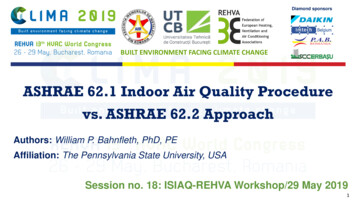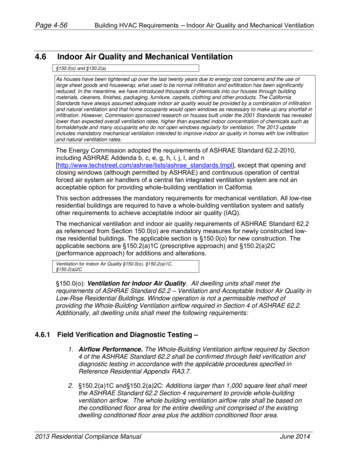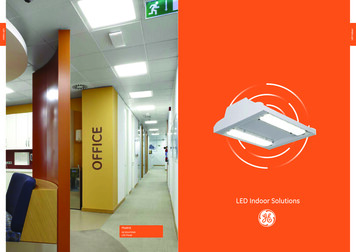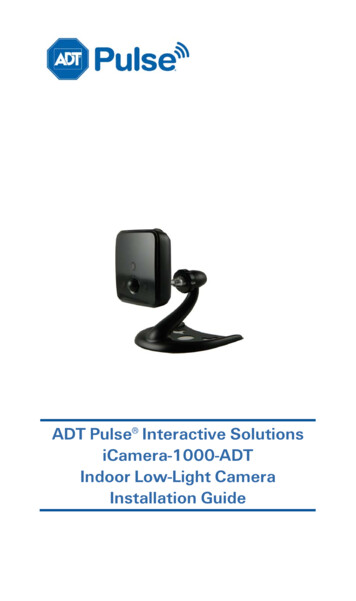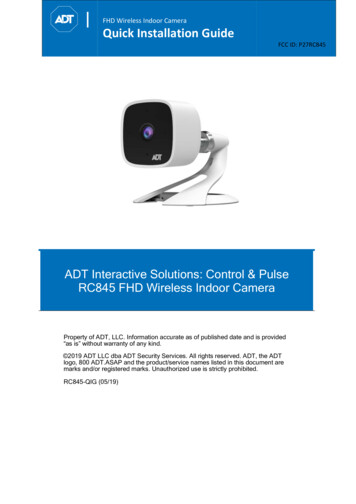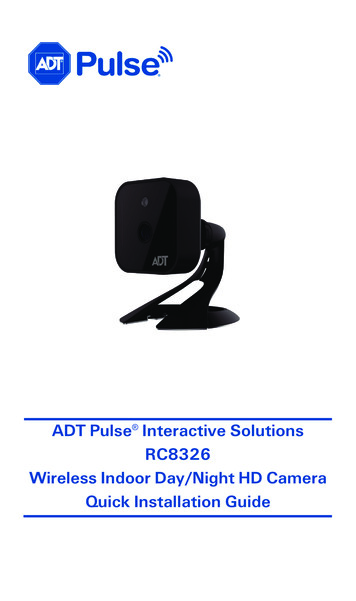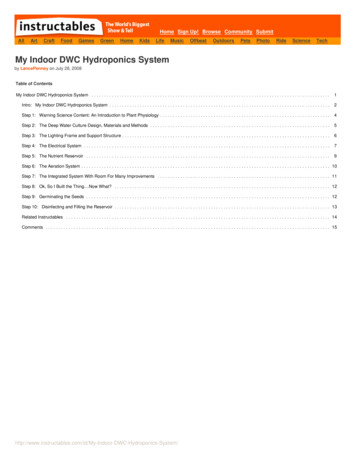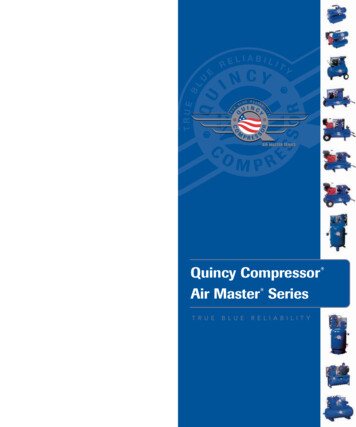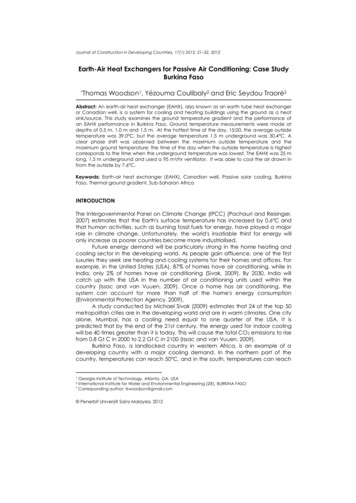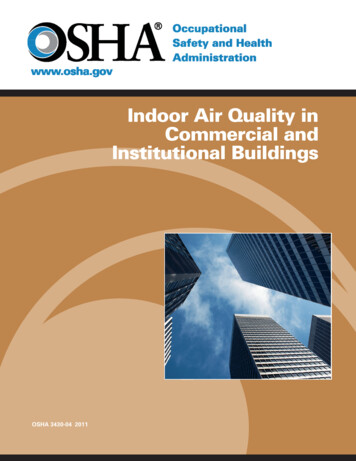
Transcription
Indoor Air Quality inCommercial andInstitutional BuildingsOSHA 3430-04 2011
Occupational Safety and Health Act of 1970“To assure safe and healthful working conditionsfor working men and women; by authorizingenforcement of the standards developed underthe Act; by assisting and encouraging the States intheir efforts to assure safe and healthful workingconditions; by providing for research, information,education, and training in the field of occupationalsafety and health.”This publication provides a general overview ofa particular standards-related topic. This publicationdoes not alter or determine compliance responsibilities which are set forth in OSHA standards, and theOccupational Safety and Health Act of 1970. Moreover, because interpretations and enforcement policy may change over time, for additional guidance onOSHA compliance requirements, the reader shouldconsult current administrative interpretations anddecisions by the Occupational Safety and HealthReview Commission and the courts.Material contained in this publication is in the publicdomain and may be reproduced, fully or partially,without permission. Source credit is requestedbut not required.This information will be made available to sensoryimpaired individuals upon request. Voice phone:(202) 693-1999; teletypewriter (TTY) number: 1-877889-5627.
Indoor Air Quality inCommercial and InstitutionalBuildingsOccupational Safety and Health AdministrationU.S. Department of LaborOSHA 3430-042011The guidance is advisory in nature and informational incontent. It is not a standard or regulation, and it neithercreates new legal obligations nor alters existing obligationscreated by OSHA standards or the Occupational Safety andHealth Act. Pursuant to the OSH Act, employers mustcomply with safety and health standards and regulationsissued and enforced by either OSHA or by an OSHAapproved State Plan. In addition, the Act’s General DutyClause, Section 5(a)(1), requires employers to provide theirworkers with a workplace free from recognized hazardslikely to cause death or serious physical harm.
ContentsIntroduction3Background3Benefits of Mitigation of IAQ Problems4Health Effects4Sources of Indoor Air Pollutants5Common Pollutant Categories6Prevention or Control IAQ Problems6IAQ Management Approach6Identification and Assessment7Control Methods7Seeking Professional Assistance8Applicable Standards andRegulationsOSHA StandardsStandard Interpretations999State Programs10National Consensus Standards10OSHA Assistance, Servicesand ProgramsAppendix A: Common Indoor AirContaminants16Appendix B: Steps to ImproveIndoor Air Quality19Appendix C: HVAC SystemMaintenance Checklist20Appendix D: Investigating IAQProblems and Complaints21Appendix E: Selected Resources22Hazard Recognition22Evaluation and Control23Appendix F: OSHA-SponsoredEnvironmental Tobacco SmokeWorkshopsWorkshops I - IIIReferences112Occupational Safety andHealth Administration252526
IntroductionBackgroundIndoor air quality (IAQ) is a major concern tobusinesses, schools, building managers, tenants,and workers because it can impact the health,comfort, well-being, and productivity of the buildingoccupants. OSHA recognizes that poor IAQ can behazardous to workers’ health and that it is in thebest interest of everyone that building owners,managers, and employers take a proactive approachto address IAQ concerns.IAQ has been identified by the EPA as one of thetop five most urgent environmental risks to publichealth (2). The Centers for Disease Control andPrevention (CDC) estimates that the majority ofAmericans spend approximately 90 percent of theirtime indoors (3). On average, office workers spendapproximately 40 hours a week in office buildings.These workers also study, eat, drink, and, in certain work settings, sleep in enclosed environmentswhere make-up air (i.e., fresh air added to recirculated air) may be compromised. For thisreason, some experts believe that more people maysuffer from the effects of indoor air pollution thanfrom outdoor air pollution.This OSHA guidance document on IAQ providespractical recommendations that will help preventor minimize IAQ problems in commercial andinstitutional buildings, and help resolve suchproblems quickly if they do arise. It provides flexibleguidance to employers to help them keep their buildings free of pollutants or conditions that leadto poor IAQ. It also provides information on good IAQmanagement, including control of airbornepollutants, introduction and distribution of adequatemake-up air, and maintenance of an acceptabletemperature and relative humidity. Temperature andhumidity are important because thermal comfortunderlies many complaints about “poor air quality.”Some of the information presented here has beenderived from the Environmental Protection Agency’s(EPA) report, “An Office Building Occupant’s Guideto IAQ” (1)1 and other documents listed in AppendixE, Selected Resources. The issue of environmentaltobacco smoke will only be addressed in AppendixF, or indirectly in discussions of air quality relative tosome possible components of tobacco smoke, e.g.,carbon monoxide, carbon dioxide, particulates, etc.In 1998, OSHA conducted a series of three workshopson this issue and the proceedings of these workshops were published in 1999. See Appendix F formore information.This document is directed primarily at employers,building owners and managers, and othersresponsible for building maintenance, but may alsobe used as a basic reference for all those involvedin IAQ issues. Furthermore, information presented here can help with the decision of whether ornot the services of an outside professional may beneeded. The advice of a medical professional shouldalways be sought if there are any immediate healthissues. Contractors and other professionals (e.g.,industrial hygienists or other environmental healthand safety professionals) who respond to IAQconcerns, as well as members of the general public,may also find this information helpful.1 The numbers in parentheses refer to specific entries in the lastsection of this document titled “References.”Each building has its own set of circumstances.Air quality may be determined by the site of thebuilding, its original design, renovations, whetherair handling systems have been maintained,occupant densities, activities conducted within thebuilding, and the occupants’ satisfaction with theirenvironment. IAQ problems can arise from a singlesource or any combination of factors. InadequateIAQ may begin with poor building design or failureof the building enclosure or envelope (roof, facade,foundation, etc.). Other issues may be associatedwith the location of the building and mixed uses ofthe building. Many common IAQ problems areassociated with improperly operated and maintainedheating, ventilating and air-conditioning (HVAC)systems, overcrowding, radon, moisture incursionand dampness, presence of outside air pollutants,and the presence of internally generated contaminants such as use of cleaning and disinfectingsupplies and aerosol products, off-gassing frommaterials in the building, and use of mechanicalequipment. Improper temperature and relativehumidity conditions can also present problems,especially concerning comfort.Many IAQ complaints are associated with flawsin building design and by inadequate routinepreventive maintenance of building enclosures(envelopes), plumbing, and HVAC systems (2, 4, 5).To resolve many IAQ problems, a preventive maintenance program should be established based onthe system’s recommended maintenance scheduleoutlined by the architect or engineer, the manufacturer, or an HVAC professional. Regular preventivemaintenance not only ensures that systems areoperating properly, but also can result in costsavings, improved operating efficiency, andincreased worker productivity (6). The U.S. GreenINDOOR AIR QUALITY IN COMMERCIAL AND INSTITUTIONAL BUILDINGS3
Building Council (USGBC), among others, hasdemonstrated that IAQ issues can be readily andpractically addressed when building systems areretrofitted for energy efficiency. (http://www.usgbc.org/DisplayPage.aspx?CMSPageID 221#v2008)Benefits of Mitigation of IAQ ProblemsGood IAQ in buildings is an important componentof a healthy indoor environment. It contributes to afavorable and productive environment for buildingoccupants, giving them a sense of comfort, health,and well-being. Significant increases in workerproductivity have also been demonstrated whenthe air quality was adequate (6). Research has alsoshown that workers in buildings with adequate airquality have reduced rates of symptoms related topoor air quality (7).Health EffectsSymptoms related to poor IAQ are varied depending on the type of contaminant. They can easily bemistaken for symptoms of other illnesses such asallergies, stress, colds, and influenza. The usual clueis that people feel ill while inside the building, andthe symptoms go away shortly after leaving thebuilding, or when away from the building for aperiod of time (such as on weekends or a vacation).Health or symptom surveys, such as the oneincluded in Appendix D, have been used to helpascertain the existence of IAQ problems.Research has linked building dampness withsignificant health effects. Numerous species ofbacteria and fungi, in particular filamentous fungi(mold), can contribute significantly to indoor airpollution (4, 15-20). Whenever sufficient moisture ispresent within workplaces, these microbes can growand affect the health of workers in several ways.Workers may develop respiratory symptoms,allergies, or asthma (8). Asthma, cough, wheezing,shortness of breath, sinus congestion, sneezing,nasal congestion, and sinusitis have all beenassociated with indoor dampness in numerousstudies (21-23). Asthma is both caused by andworsened by dampness in buildings. The mosteffective means to prevent or minimize adversehealth effects is to determine the sources ofpersistent dampness in the workplace and eliminate them. More details on preventing mold-relatedproblems can be found in the OSHA publicationtitled: “Preventing Mold-Related Problems in theIndoor Workplace” (17). Other environmental factors such as poor lighting, stress, noise, and thermaldiscomfort may cause or contribute to these healtheffects (8).Failure of building owners and operators to respondquickly and effectively to IAQ problems can lead tonumerous adverse health consequences. Healtheffects from indoor air pollutants may be experienced soon after exposure or, possibly, years later(8, 9, 10). Symptoms may include irritation ofthe eyes, nose, and throat; headaches; dizziness;rashes; and muscle pain and fatigue (11, 12, 13, 14).Diseases linked to poor IAQ include asthma andhypersensitivity pneumonitis (11, 13). The specificpollutant, the concentration of exposure, and thefrequency and duration of exposure are allimportant factors in the type and severity of healtheffects resulting from poor IAQ. Age and preexistingmedical conditions such as asthma and allergiesmay also influence the severity of the effects. Longterm effects due to indoor air pollutants may includerespiratory diseases, heart disease, and cancer, all ofwhich can be severely debilitating or fatal (8, 11, 13).4Occupational Safety andHealth Administration
Sources of IndoorAir PollutantsThe relative importance of any single sourcedepends on how much of a given pollutant it emits,how hazardous those emissions are, occupantproximity to the emission source, and the abilityof the ventilation system (i.e., general or local) toremove the contaminant. In some cases, factorssuch as the age and maintenance history of thesource are significant.Sources of indoor air pollution may include:Building Site or Location: The location of a buildingcan have implications for indoor pollutants.Highways or busy thoroughfares may be sourcesof particulates and other pollutants in nearbybuildings. Buildings sited on land where there wasprior industrial use or where there is a high watertable may result in leaching of water or chemicalpollutants into the building.Building Design: Design and construction flawsmay contribute to indoor air pollution. Poorfoundations, roofs, facades, and window and dooropenings may allow pollutant or water intrusion.Outside air intakes placed near sources wherepollutants are drawn back into the building (e.g.,idling vehicles, products of combustion, waste containers, etc.) or where building exhaust reenters intothe building can be a constant source of pollutants.Buildings with multiple tenants may need anevaluation to ensure emissions from one tenant donot adversely affect another tenant.Renovation Activities: When painting and otherrenovations are being conducted, dust or otherby-products of the construction materials are sources of pollutants that may circulate through a building. Isolation by barriers and increasedventilation to dilute and remove the contaminantsare recommended.Local Exhaust Ventilation: Kitchens, laboratories,maintenance shops, parking garages, beauty andnail salons, toilet rooms, trash rooms, soiled laundryrooms, locker rooms, copy rooms and otherspecialized areas may be a source of pollutantswhen they lack adequate local exhaust ventilation.Building Materials: Disturbing thermal insulation orsprayed-on acoustical material, or the presence ofwet or damp structural surfaces (e.g., walls, ceilings)or non-structural surfaces (e.g., carpets, shades),may contribute to indoor air pollution.Building Furnishings: Cabinetry or furniture madeof certain pressed-wood products may releasepollutants into the indoor air.Building Maintenance: Workers in areas in whichpesticides, cleaning products, or personal-careproducts are being applied may be exposed topollutants. Allowing cleaned carpets to dry withoutactive ventilation may promote microbial growth.Occupant Activities: Building occupants may bethe source of indoor air pollutants; such pollutantsinclude perfumes or colognes.Building Systems Design and Maintenance:
24.01.2003 · (202) 693-1999; teletypewriter (TTY) number: 1-877-889-5627. Indoor Air Quality in . Commercial and Institutional . Buildings . Occupational Safety and Health Administration . U.S. Department of Labor. OSHA 3430-04 2011. The guidance is advisory in nature and informational in . content. It is not a standard or regulation, and it neither . creates new legal obligations nor alters
